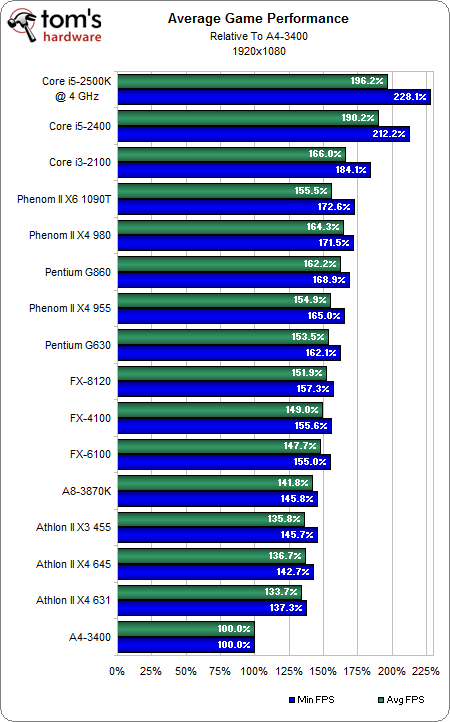Picking A Sub-$200 Gaming CPU: FX, An APU, Or A Pentium?
We really like to hunt down great values in the processor space. Since our last round-up of affordable CPUs, AMD released its Llano-based APUs and Bulldozer-based FX family. Also, Intel introduced a handful of Sandy Bridge-based Pentium chips.
AMD Or Intel: Which Offers Better Gaming Performance?
That’s a lot of data to digest, so let’s distill it down by averaging out performance in all benchmarks relative to AMD's A4-3400. Again, we sort by minimum frame rate because we're calling that statistic more important than the average. It's the best way to quantify the benefit of a powerful-enough processor, representing its ability to stand up to a worse-case scenario.
If the above chart presents any surprises, they'd be the dual-core Pentium G630 and G860, which perform incredibly well, matching up to AMD's former Phenom II X4 955 flagship. At $80 and $100 respectively, both Sandy Bridge-based Pentiums boldly snatch the budget gaming CPU recommendation from the Athlon II CPUs we’re used to seeing dominate this segment. Granted, AMD's lowest-priced models are starting to go extinct as the company's APUs gain prominence anyway.
To that end, we were hoping to see the Llano-based APUs succeed the inexpensive Athlons under $100, impressing gamers with discrete graphics cards on strict budgets. Unfortunately, the results don't reflect a net gain. Even the multiplier-unlocked A8-3870K is unable to distinguish itself overclocked to 3.6 GHz.
With the sub-$100 Pentiums performing so well, Intel's $125 Core i3-2100 easily beats more expensive Phenom II and FX models. And the $190 Core i5-2400 dominates the sub-$200 landscape without challenge, really. As such, we're almost-shockingly left without an AMD CPU to recommend at any price point.
While it’s true that AMD’s multiplier-unlocked models appeal to tweak-happy power users, the company's overclocked game performance manages to either hang close to or fall just behind Intel's stock Core i3-2100. Pumping up voltage, multipliers, and, consequently, power usage seems like a futile exercise just to keep pace with an efficient $125 budget-oriented chip running at its default settings.
The biggest flaw with Intel's low-end offerings is that the Pentium family limits you to dual-core configurations. Our concern is that, outside of a game, you're going to find situations where the two cores hurt performance in other applications. Having said that, the Pentium G630- and G860-based machines were snappy throughout testing, and their lack of Hyper-Threading didn't negatively impact our experience.
AMD’s Phenom II X4 955 and FX-4100 could certainly appeal to buyers who insist on the ability to handle four threads at a time. At their $125 and $110 respective price points, however, they’re too close to the Hyper-Threaded Core i3-2100 to earn a distinguished recommendation. In our last sub-$200 gaming CPU round-up, we showed that the Core i3-2100 can match AMD's Phenom II X4 955, even while background tasks run in parallel with a game. So, we couldn't even speculate that Intel's Core-i3 2100 might disappoint in a real-world environment with applications running in the background.
Get Tom's Hardware's best news and in-depth reviews, straight to your inbox.
Interestingly, the best gaming value in AMD's FX family is its affordable FX-4100. Neither the FX-6100 nor the FX-8120 offer an advantage over this $110 model. Otherwise, things look bleak for AMD enthusiasts hunting for a new gaming rig. You can make the argument that the frame rates offered by FX and Phenom II processors are sufficient, but that's a tough stand to take in light of the competitive benchmarks. Let's be clear; in GPU-bound games, you wouldn't be able to tell the difference. But, to be perfectly frank, Intel's processors are the obvious choice in titles that do demonstrate reliance on host processing power. It simply doesn’t make sense to spend more for less. And, in many games, high-end AMD processors demonstrate a quantifiable performance deficit compared to the Core i3-2100. For $190, a stock Core i5-2400 gets you more gaming prowess than any AMD CPU can hope to deliver right now, even overclocked.
We have our fingers crossed that the upcoming Trinity-based APUs and Piledriver-based FX CPUs will augment IPC and, consequently, improve AMD's gaming performance story. At the same time, it'll have to contend with Intel's soon-to-be-released Ivy Bridge-based processors.
Current page: AMD Or Intel: Which Offers Better Gaming Performance?
Prev Page Overclocking BenchmarksDon Woligroski was a former senior hardware editor for Tom's Hardware. He has covered a wide range of PC hardware topics, including CPUs, GPUs, system building, and emerging technologies.
